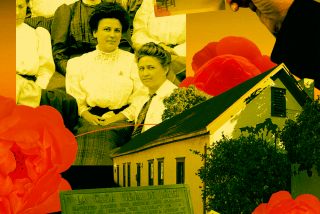An Esther McCoy revival tells story of L.A.’s modern architecture
Esther McCoy is having a moment. The architecture critic and historian, who died in 1989 at age 85, is the subject of a smart Pacific Standard Time exhibition at the Schindler House in West Hollywood, building on McCoy’s deep connections with Rudolph Schindler himself. The show is accompanied by a Getty-funded catalog, and early next year East of Borneo Press will publish “Piecing Together Los Angeles,” an anthology of McCoy’s essays on architecture.
What this turn in the spotlight will make clear to the public is what every architecture critic who has spent significant time in this city already knows: It was McCoy who first gave shape to the story of modern architecture in Los Angeles. She explained our best architects and their finest work to the rest of the country and the world. And she did it in a remarkably fearless and readable way.
Her best-known book, 1960’s “Five California Architects,” still reads like a fresh, argumentative guide to a creatively fertile foreign country, so patently does it assume — and with good reason — that its readers are in part confused and in part eager to be enlightened about this band of eccentric architects putting up flat-roofed houses on palm-lined streets. Reyner Banham, the great British critic and a dedicated lover of Los Angeles, said of McCoy, “No one can write about architecture in California without acknowledging her as the mother of us all.”
To a large extent the McCoy revival has been engineered by the architectural historian Susan Morgan. With Kimberli Meyer, who oversees the MAK Center at the Schindler House, Morgan curated the exhibition, which has been extended through Jan. 29, and she edited the anthology and wrote its thorough, entertaining introduction.
McCoy always had a complicated relationship with the architectural and cultural establishment, which was based in those days almost exclusively on the East Coast. She was rejected by the Guggenheim Foundation when she was trying to get the research for “Five California Architects” off the ground in 1953. Los Angeles was more isolated from New York and Washington in those days than it is now; as a female chronicler of a West Coast avant-garde, McCoy was trying to climb a pole greased many times over.
And she had an independent streak that had a lot more to do with personality than gender or geography. As Banham put it, “She knew her stuff, was a real scholar, though she seemed to belong to no known academic faction or school of thought.”
There is nonetheless a fierce consistency to her writing and her point of view, something that is immediately apparent in both the MAK Center show and the forthcoming anthology. Her goal was to analyze and humanize the breakthrough work of L.A. modernists — especially Schindler, in whose office she worked as a draftswoman from 1944 to ’47.
And in describing the works of these architects McCoy was often describing Los Angeles, the young, wide-open and fast-growing city she had adopted after growing up in Kansas and spending her 20s in New York. “A Schindler house is in movement,” she wrote in her first major essay on architecture, commissioned by editors at Direction, a small East Coast journal. “It is becoming.”
In another famous and typically effortless phrase, she described California’s Midcentury design as a “marriage between Walden Pond and Douglas Aircraft.”
McCoy, who worked as an assistant to the novelist Theodore Dreiser in her Manhattan days (a relationship that continued when he too moved to California), also wrote fiction throughout her long career, selling short stories to the New Yorker, Harper’s Bazaar and other magazines. But bringing attention to the underappreciated architects of the West Coast — who in 1960, when “Five California Architects” appeared, had none of the broad fame we now take for granted — became and then remained the focus of her work.
As she put it, in Los Angeles there was “an extraordinary amount of provocative architecture within easy reach.”
christopher.hawthorne@latimes.com
More to Read
The biggest entertainment stories
Get our big stories about Hollywood, film, television, music, arts, culture and more right in your inbox as soon as they publish.
You may occasionally receive promotional content from the Los Angeles Times.






